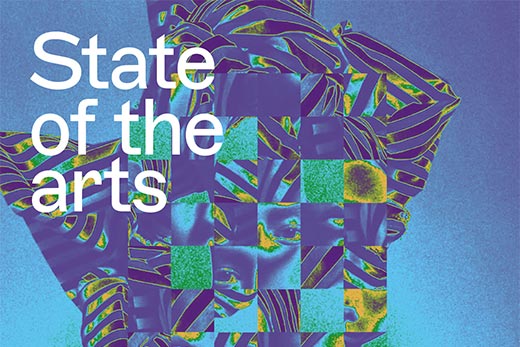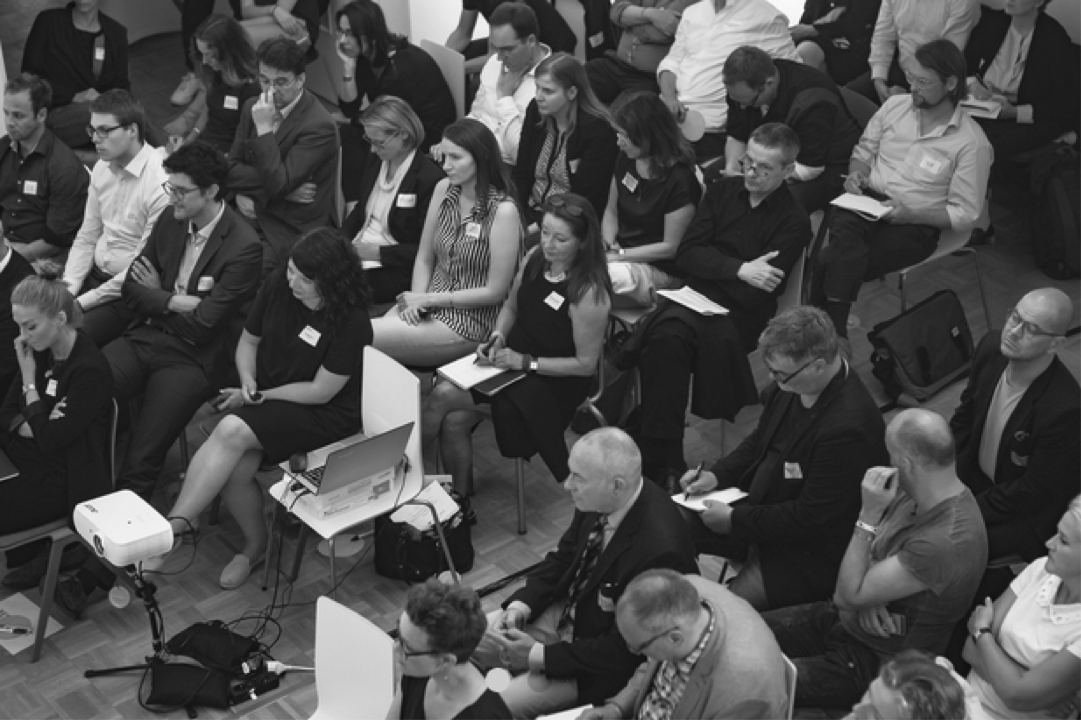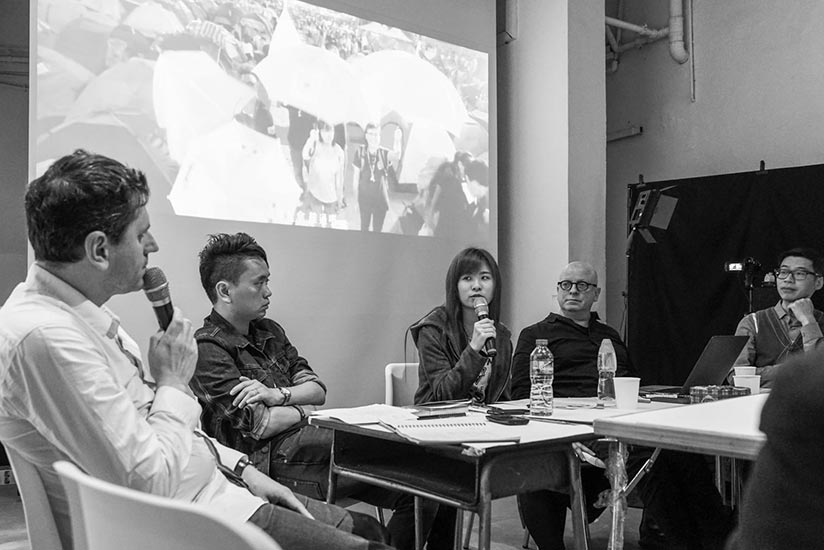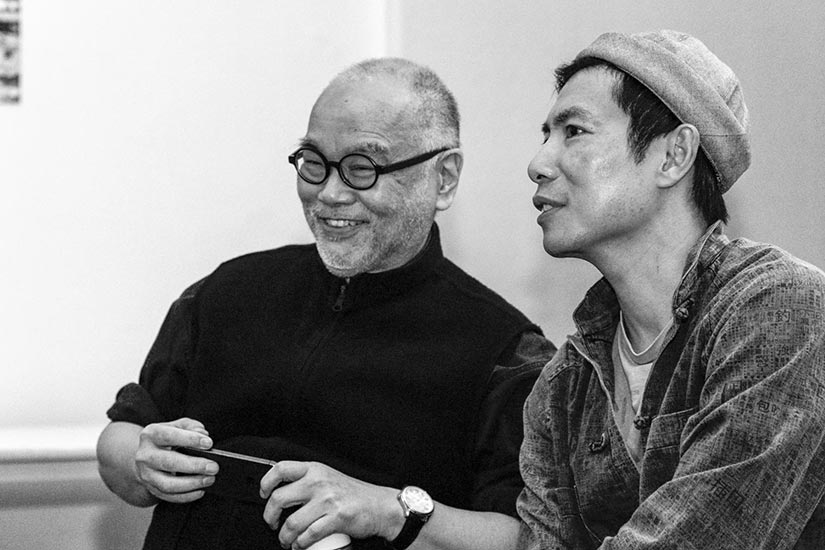Article “Underpolicies of Sustainable Media”
Article on the occasion of the “State of the Arts” symposium by Jacopo Rasmi (Université de Lorraine).
Before asking our selves how to up date our cultural policies in the wake of the current digital and the ecological era, we might first challenge the very idea of « cultural policy » itself and all its possible and harmful connec- tions to governmental and bureaucratic rules (Agamben, 2018; Graeber, 2015) that binds State and Market in a close embrace. Even if the positive outcomes of a well-oriented policy for the cultural sector should be taken into consideration and highlighted, our focus here is to try to challenge and displace the general notion – should we say dispositif? – of « cultural policy » by thinking through the point of view of sustainable media.
We believe that media – those infrastructures responsible for the distribution of the cultural contents and the disposition of our everyday attention – represent a crucial layer of so-called « culture » and its politics (Kittler, 1999): so important are these media that one could conceive their action not just in terms of connection and delivery [infra, between] of already existing elements but also – and above all – in terms of the prior formatting of the concrete ecosystem through which this « content » becomes accessible (Parikka, 2011). Thus, media – as the technical a priori of our social systems – should be understood as intrastructures [intra, within] acting from the inside as a powerful force shaping the whole social milieu (Citton, 2017).
Toward ecological intrastructures
First of all, what might « sustainability » or « ecology » mean when applied to the field of media? The most immediate connection we might draw between media operations and ecological issues could be a strictly ma- terial one: for instance, we could pay attention the e-waste generated by our screen technologies or the energy needed to keep cloud servers running. A lot of studies have brought such invisible but concrete footprints of our communication networks under the spotlights (e.g. Flipo, 2007). But the relation between media and eco- logy could be understood in a more complicated way. The work of the french philosopher Felix Guattari gives us a few interesting hints for how to articulate this field of deeper and more entangled connections.
Guattari (2000) could help us to overcome the simple idea that ecology is just a matter of taking care of our material – or « natural » – environments. This idea of ‘taking care’ is not wrong but we should widen its focus by reframing the material environment as just one dimension of a multiple ecology, in which (at the very least) we should add our social and our mental environments. Guattari suggests that the ecological paradigm is too narrow if it doesn’t arrive at this triple and overlapping structure binding together « natural » milieu, society and subjectivity. Hence, the urgent changes that ecology demands have to cross all these layers.
If the ecological movement was supposed to protect our material environment from capitalist exploitation and vertical management, it now becomes also responsible for defending our social and mental environments from similar dangerous logics of domination and value extraction. Within such a conceptual and political frame, Guattari invites us to consider that any transition to sustainability must include a transition from societies where media are driven and controlled by monopolies toward societies where they could be run in a more open and autonomous ways by a large ensemble of communities, supporting a wide range of uses.
An essential programmatic point for social ecology will be to encourage capitalist societies to make the transition from the mass-media era to a post-media age, in which the media will be reappropriated by a multitude of subject- groups capable of directing its resingularization. Despite the seeming impossibility of such an eventuality , the currently unparalleled level of media-related alienation is in no way an inherent necessity. (Guattari, 2000, p 61)
In the present situation of « mass-mediatic » organization, renewed once again by the internet giants that McKenzie Wark (2004) call « vectorialist », we should – according to Guattari – fight to build a « post-media- tic » media environment that would intra-structure our cultural worlds (situated between the social and the mental) in a different, more ecological way.
Post-growth media
As stated at the beginning, we believe that bridging the gap between media practices and ecological theories opens up an interesting field for criticizing and transforming the debate around the policies designed to shape our cultures. The conceptual toolkit that environmentalism has defined to talk about and act within our eco- systems has to be applied to cultural infrastructures that record, stocks, treat and distribute information and creates content : that is, media.
Could we, for instance, take into account and foster a certain degree of wildness in media development as we try to do in our relations with our (natural) environments? Media ecologies might push us to acknowledge and protect precious spaces of spontaneous growth, entanglement and multiplication of media devices and prac- tices. Do our media respond – in sensible and fair ways – to the heterogeneous needs of all the elements parti- cipating in their systems? In this case, we could say they are sustainable. Or do they try to exploit those elements taking part in their environment in order to accumulate private, financial value in a capitalist fashion, that also operate in the attentional and cognitive field (Franck, 2005)? Do our media enhance and feed cultural bio- diversity, that is, a plurality of social and mental life-forms, rather than the homogenization taking place all too often within the “plantations” of the mass-media – even in the context of the internet where its « long tail » hope reveals more and more its limits (Anderson, 2004). Are our media non-polluting or ,rather, are they respon- sible for polluting the space between and within us all? This is not just a matter of burning fossil fuels in order to produce electricity for our smartphones but also a matter of constantly filling our attentional environments with aggressive advertising or continuous notifications…
Ecological movements have become more and more aware of the (dangerous) limits of the growth model that has been ruling our social and economic development since the industrial revolution. An extreme awareness of this unsustainable situation can be found amongst several groups that have been analyzing and denouncing the coming threat of global collapse hidden in our growth agenda : from the french movement of Collapsologie to the the youth militancy of Friday for future. To what extent could the subversion of these growing movements take root within the current media field? From Facebook to YouTube, today’s creative and communication economies seems to be driven by a growth horizon that push us to increase restlessly our followers, our com- ments, our likes, ours funders and give us the instruments to reach and measure these processes of expansion. Statistics, marketing training, communication management…
How about a post-growth media, as an alternative to this approaches of expansion, conquest and capitalization in the communication field? These media would set up little circuits, where the loss of audience, velocity and financial means would be counter-balanced by the gain of more engaged and caring publics, but also by fos- tering of proximity between spectators, content producers and distributors. They would be lighter, slower and less attractive. And they also would embody and test alter-economies (Massumi, 2018) opening up new spaces of self-organization, re-distribution of value and work as well as mutual help.
Cultural underpolicies
Which kind of policies – if any – could be suitable for these post-mediatic ecologies and feed their development? This is a rather delicate question that might need to be considered outside the perspectives of both the State and the market; that is, the two poles that usually (over)determine this field. We need to leave the governmental perspective so deeply rooted in our mindset and the singular work of two important US thinkers from the black movement, Stefano Harney and Fred Moten (2013), could help us to step off the usual path by giving us a different understanding of social-political organization.
In particular, their concept of « undercommons », is a powerful attempt to make visible an ability of self-orga- nization at the grassroots level that each community holds and exercises in spontaneous, reciprocal and conti- nuous experimentation out of the reach institutional and commodity structures.
Here management encounters forms of what we will call planning that resist its every effort to impose a compul- sion of scarcity through seizing the means of social reproduction. In the undercommons of the social reproductive realm the means, which is to say the planners, are still part of the plan And the plan is to invent the means in a common experiment launched from any kitchen, any back porch, any basement, any hall, any park bench, any improvised party, every night. This ongoing experiment with the informal, carried out by and on the means of social reproduction, as the to come of the forms of life, is what we mean by planning. (2013, 74)
The layer of socio-political setting that Harney and Moten call « undercommons » could not be determined or programmed from above, within the external frame of management. Instead, it is internally defined by a logic that they call « planning ». Planning becomes particularly visible in communities, such as afro-americans that have, historically, had to live on the margins of society and its institutions and, thus, had to build up its own clandestine and mobile structures.
These concepts could be easily applied to the cultural field we are interested in and the idea of a planning sphere that evades the control of management could lead us closer to the “post-mediatic” ecologies that we have started to trace. From the notion of undercommons, we might draw out the concept of underpolicies that would enable us to think cultural experiences which do not fall under the logic of institutional administration nor under the commodity principles of the market. These cultural underpolicies don’t take place within the system nor without it: we should think them, instead, beside and behind those dominant structures. In a similar fashion, such underpolicies are not supposed to engage in a frontal fight with the mainstream organisms as counter-policies, which would expend precious time and energies in a battle that they would probably lose because of the size of the ennemies faced. Nor do they collaborate with them as macro-policies, in a deleuzian vocabulary. They do not work in a binary and binding attitude: the question is not whether one is against or for cultural policies. Underpolicies work beyond and despite the dominant system organizing and funding cultural activities in our societies.
This is not a manifesto
Despite the register of what we have said so far, this is not a manifesto nor an explicit program, listing accurately criteria and definitions, as is usual in the militant or intellectual tradition. It would be contradictory and incon- sistent in light of the principles leading the experiences we are advocating for. In fact, underpolicies do not need an accurate schema, like the charts produced within normal policy-making in the cultural field which can be translated into precise rules and complicated budgets at a decisional and governmental level. That’s why we avoided titling this modest text « underpolicies for sustainable media ». That’s why we preferred to speak of « underpolicies of sustainable media », but we might also have said « underpolicies from sustainable media ». Let’s approach our proposition as a « diagram » instead than a manifesto, a diagram that we are drawing to make sense of the complex varieties of living phenomena and events as they appear to us (Deleuze, 1986).
Within such a perspective, it becomes necessary to move towards particular, situated cases that, in multiple ways, embody what we call « underpolicies ». It will be an open and unfinished catalogue of examples. Examples, as Agamben has stated several times (2008), are those operators on thought that bridge the gap between universality and particularity, or rather between the idea and the living situations. The examples of « sustainable media » that we will outline briefly represent some of the possible points for sketching a diagram of current underpolicies. The concept of « im-mediation » (Rasmi, 2019) – that is flexible mediations which adapt themselves to particular, ephemeral conditions – could also be used for defining the structures that we gather around these paradoxical cultural policies.
(1) Open DDB, a Créative Commons platform
The first case we wanted to mention is an Italian adventure based in Bologna which has been running since 2013. Financed mainly by crowdfunding together with the one-off support of a private grant (for internationa- lization), Open DDB try to set up an intrastructure for the « distribution from below », that is the literal tran- slation of their name « Distribuzioni Dal Basso ». Since its inception, this initiative emerged from the self- organization of cultural creators – namely the film-making collective SMK – facing the lack of institutions and resources that might enable “minor” content (in their case, documentary and militant cinema) to circulate and meet potential publics. The missing spectators corresponded with a paucity of funds supporting the creation of this type of content that often relies on self-production or other similar forms of alternatives economies (Cadei, 2019).
The platform gathers a multimedia catalogue ranging from cinema (the core sector) to music and books. The contents are provided directly by their authors and are curated by an engaged editorial team. All the content has to be registered under a Creative Commons licence that allows a particular kind of economic exchange driven by the principle of the gift. In order to get access to content – either digital or physical – on the Open DDB platform, the user can give as much as they want or can and can make use of the content within the perimeter defined by the CC licence chosen by its author. The platform, of course, suggests an average amount of money that ensures the sustainability of the circuit.
This sustainability is not measured on a profit basis or the extraction of private value, but it is rather conceived as an equitable taking care of the needs and the interests of all the members of the distribution network (public, media, creators), over the long term. After having taken off the fee needed by the platform to keep on working, the donation given by users goes directly to the authors of content in order to let them continue their practice based on autonomy. The platform embodies the logic of bringing together spectator and the author, making them collaborate closely.
The same principle explains the attempt to go beyond the digital in order to develop a programme of events. For example, Open DBB also promote screenings of the films on the catalogue in a collective context that, most of the time, are hosted by engaged communities: from associations to squats. Between digital delivery and the organization of events, the main aim of Open DDB is to create a strong meshwork of caring relationships that tries to lead the cultural and creative field beyond the dynamics of industrial production and consumer economy towards a convivial network (Illic, 1973).
(2) UbuWeb, a money-free distribution
Crossing the ocean and going back to the nineties, we could find another interesting example of a distribution (alter)platform. We refer to the experience of UbuWeb, born in the States in 1996 and still existing 25 years later (Goldsmith, 2019). On UbuWeb, the user can get access to a wide range of rare cultural works – from videos to texts, mainly by avant-garde movements – that have no official distributor or circulate only through the really narrow and elitist spaces of museums and galleries. In both cases, most of the contents of this platform have no mainstream and commercial value.
UbuWeb do not ask the public for money to use the platform. But it does not pay for the rights for the contents that the platform is hosting and distributing. It relies on a money-free economy that does not acknowledge any property constraints. Therefore, UbuWeb relies on a hacking logic which could be denounced as « illegal » or « pirate » from the viewpoint of the dominant ownership codes. Following a perfectly coherent logic, this money-free economy also includes the work of hosting and editing the platform, which is entirely run on vo- lunteering basis through a caring and spontaneous network that isn’t bound to wages or directions from policy or management.
A key challenge for this organization is that of the servers needed by the platform to keep running its services of archiving and delivery: a quite expensive problem. Throughout the years, these infrastructures has been provided by allied institutions – mostly universities – in an informal exchange that implies a certain degree of precarious nomadism and uncertainty. The objective of the platform is not to survive at any cost or to expand its activities and its publics – no advertising is made, the site hinders Google’s spiders…UbuWeb represents an on-going experiment at the limit, and in the shadow, of the current system (the State and the Market) that will go on as long as its caring network will be able to sustain and defend it. The choice of simple coding and straightforward interface constitutes an essential strategy for preserving this autonomy and making it last: this simplicity means there is no need to externalize the management of the digital infrastructure to outside experts.
(3) Cinema voyageur, an ambulant screening adventure
The third and last example of underpolicies in the cultural field come from the french territory: the Cinéma Voyageur, a nomadic movie distribution intrastructure dating back from 2009. Each summer, for the last ten years, Cinéma Voyageur has set out for a three months long tournée – in rural France mainly – trying to reach off-centre, marginal publics that do not usually have access to a proper cinematic infrastructure. Indeed, most of the spectators of Cinema Voyageur live in countryside or suburbs. Instead of asking them to travel the distance to existing cultural institutions (in towns and cities), it’s the film distribution that visits them. However, it’s not a matter of simple delivery, a variation of the one that those people could experience daily through the television broadcasting or on demand services. Cinema Voyageur schedules its screenings and debates with publics themselves – or, at least, a part of them. In its nomadic peregrination, it stops only where someone can host and co-program the event. Every screening, therefore, is co-organized by the people (an association, a small mairie, a family…) situated in a specific context.
The catalogue of films carried around by this joyful caravan - which reminds us that the birth of cinema dis- tribution was in the travelling infrastructures of the fair - is entirely composed of films registered under free licences (from the already quoted Creative Commons to Copy Left), coming mainly from independent pro- ductions (Mahieu K., 2014). This condition immediately frees Cinema Voyageur from expensive budgets and tight programs : they can project any of their films at any time, improvising the screening each evening accor- ding to the places they find themselves, the spectators they meet and the will and whim of the team. Here, one can understand in a straightforward way why we were talking about « im-mediation »… As in the case of Open DDB, the free licence model – coming mainly from the culture of the web – allows the distribution initiative to work within a gift economy where the most important principle is one of sustainability.
Access to every screening is free and a donation is suggested. The money earned isn’t used to pay wages but only to cover the daily costs of the operation (the fuel, the technical means, the food…). All the work provided, in fact, does not imply remuneration: everything relies on a mutual help and self-organization. This kind of engagement is mostly fed by a shared interest in minor and critical cultural content and the possibility (and promise) of gathering unpredictable publics around them, rather than any elitist tendency. Even if the most significant part of the work of Cinéma Voyageur is in showing cinematic works in search for visibility, (minor lengths, non-fictional genres, independent productions…), they have also developed a bookshop, la Distro, that follows the screening, displaying and selling small and not so accessible editions, ranging from books to fanzines.
To be continued
These three examples come from our own experience : we came across them, we used them or worked through them, we have met the people behind their initiatives, sometimes we have even been collaborating with them… All of them share in the attempt to intra-structure differently our cultural space (1) by distributing minor con- tent that do not benefit from the commercial circuit, nor from institutional support, (2) by shaping different forms of spectatorship, (3) by testing economies that are not based on sales and salaries and, last but not least, (4) by choosing legal frames where ownership and private property codes are weakened. The compendium has just begun…
[thanks to the support of Marc Higgin]
Bibliography
- Giorgio Agamben, Homo Sacer. L’integrale, Macerata, Quodlibet, 2018.
- Giorgio Agamben, Signatura Rerum. Sul metodo, Torino, Bollati e Boringhieri, 2008.
- Chris Anderson, « The long tail », Wired, 2004.
- Claudio Cadei, « Une plateforme de distribution digitale autogérée : Open DDB », La Revue Documentaires, n. 30, 2019.
- Yves Citton, Médiarchie, Paris, Seuil, 2017.
- Gilles Deleuze, Foucault, Paris, Minuit, 1986.
- David Graeber, The utopia of rules, New York, Melville House, 2015.
- Felix Guattari, The three ecologies, New York, Athlone Press, 2000.
- Kenneth Goldsmith, « Le manifeste polémique d’UBUWEB », Multitudes, n. 75, 2019.
- Fabrice Flipo et al., Écologie des infrastructures numériques, Paris, Hermès, 2007.
- Georg Franck, « Mental capitalism », in Michael Shamiyeh and DOM Research Laboratory (ed.s), What People Want. Populism in Architecture and Design, Basel, Boston & Berlin, Birkhäuser, 2005.
- Stefano Harney and Fred Moten, The Undercommons, Minors Compositions, 2013. Friedrich Kittler, Gramophone, Film, Typewriter, Stanford, Stanford University Press, 1999.
- Ivan Illich, Tools for conviviality San Francisco, Harper & Row, 1973.
- Brian Massumi, 99 Theses on the Revaluation of value, Minneapolis, Minnesota University Press, 2018. Mathieu K, Avec une caméra, Grenoble, Le Monde à l’envers, 2013.
- Jussi Parikka « Media ecologies and imaginer media. Transversal expansions, contractions and foldings », Fiberculture journal, n° 17, 2011.
- Jacopo Rasmi, « Machines à écriture indiciaire. Écologies attentionnelles et im-médiations documentaires » in Yves Citton et Estelle Doudet (ed.s), Archéologie des média et écologies de l’attention, Grenoble, UGA éditions, 2019.
- McKenzie Wark, A Hacker Manifesto, Harvard, Harvard University Press, 2004.







